This chapter explores evidence on attitudes to disability in India, and their implications for public policy. Attitudes of society, families and PWD themselves contribute to converting impairments into disabilities. Research in India has consistently found substantial social marginalization of people with disabilities. The attitudes of specific societies are critical in assessing both the intensity of disability (i.e. how disabling a given type or level of impairment becomes for the individual disabled person) and in assessing areas where collective action is likely to fail the disabled community, and hence public action be desirable. In addition to the attitudes of the general society, the attitudes of persons with disabilities and their families are important, in some ways even more important. At the same time, the different sets of attitudes clearly interact, so that negative views about disabled people in the broader community are likely to be internalized in many cases by people with disabilities and their household members.
Much of the literature on disability in India has pointed to the importance of the concept of karma in attitudes to disability, with disability perceived either as punishment for misdeeds in the past lives of the PWD, or the wrongdoings of their parents. As two Indian authors have put it, “At a profoundly serious and spiritual level, disability represents divine justice”. 1 At a more mundane level, people with disabilities are traditionally perceived as somehow inauspicious. Much qualitative research has found considerable social marginalization of people with disabilities in India, though most also acknowledge that the social status of the PWD’s family has an impact on their potential acceptance in society. Box 2.1 discusses images of PWD in Hindu mythology and Bollywood cinema by way of illustrating popular culture perceptions of people with disabilities.
Research from urban and rural Andhra Pradesh in the early 2000s asked people about whether disability was a punishment or curse of God.2 The researchers found around 40 percent of respondents agreeing that it was, with the share of people holding such views increasing with age, being higher among women, higher for lower socio-economic groups, and higher for those who were illiterate. Interestingly, there was not a major difference in such views between urban and rural respondents, though urban people were slightly less likely to hold such views. This is in contrast to earlier qualitative research in Karnataka, which had found higher belief in medical causes of disability in urban populations.
The present study asked a similar question for a much larger sample of households in rural UP and TN, and the results are presented in Figure 2.1. For both households with and without a disabled member, around half the respondents believed that disability was always or almost always a curse of God. The variations in this belief between the two states were not dramatic. An additional interesting result was that in UP respondents in households with a PWD had a 15 percent higher share with this belief than households without a PWD member.
|
Disability in Indian mythology and Bollywood movies
An interesting perspective on Indian attitudes to disability is two forms of mythology: the traditional Hindu myths which still play an important role in shaping social norms and values, and the “modern myth machine” of Bollywood, which has impacts on popular culture and society.
In Hindu mythology, the portrayal of people with disabilities is overwhelmingly negative, but also exhibits a strong gender bias in terms of the perceived capacities of disabled men and women. Disabled men in the Hindu myths are in some cases powerful and capable people. However, the visually impaired king Dritarashtra and the orthopedically impaired Shakuni side with the forces of evil in the Mahabharata war. Such images of powerful but evil and cruel disabled men have been reinforced by historical figures such as Taimur Lang. In contrast, women with disabilities in Hindu mythology are simply irrelevant. A prime example comes in a story from the Karthik Poornima, where Lord Vishnu refuses to marry the disfigured elder sister of Lakshmi, saying that there is no place for disabled people in heaven. The sister is instead married to a peepul tree. In Bollywood films in which PWD feature, several common images of disabled men and women emerge. Firstly, the disabilities of hero(ine)s are typically acquired after birth rather than congenital, “normalizing” the actor somewhat. Equally, the disability is quite often cured during the course of the film. In addition, the stars are often from better-off socio-economic strata, with resources to promote their integration, though they remain often dependent on others. Apart from these similarities, there are also gender differences in perceptions of disabled people in Bollywood movies. First, men with disabilities feature far more often than women with disabilities. Second, men with disabilities are often loved by a devoted woman without disabilities (as in Saajan), whereas women with disabilities are rarely loved by men without disabilities (and in cases where they are such as Mann, the men loved them before the onset of disability). Third, women with disabilities almost never attain economic self-sufficiency. While male stars with disabilities may not be very wealthy, they can attain such independence. Finally, the disabilities that women are portrayed with are very rarely ones that impact their physical appearance, so that they largely remain beautiful. Overall, women with disabilities in India cinema are doubly weak – women and women with disabilities. This contrasts to more frequent portrayals in Hollywood cinema of women with disabilities who have strength and discover independence. However, it is important also to note films that have sought to enhance the sensitivity of society towards the needs, rights, sensibilities and potential of people with disabilities - Sparsh, Black, Koshish (both old and new), Jagriti, Dosti, Main Aisa hi hun and Koi Mil Gaya to name a few. Lagaan is an excellent example of a mainstream film that has highlighted the process of inclusion of a dalit disabled person. In the absence of opportunities for interaction between people with disabilities and society at large, such films have played an important role in highlighting aspects of the lives of people with disabilities that are not clearly understood and in dispelling myths and biases that society holds about them. Films such as those noted have also demonstrated the attempt of non-disabled people to understand people with disabilities. At a different level, there are initial but interesting initiatives in the NGO sector on the issues of media and people with disabilities. There have been already two national film festivals on disability issues, and a third focusing on mentally challenged people was held in November 2006. Related to this, NGOs have also tried more directly to stimulate film and media material by PWD themselves, and to engage the Indian film and television industry on disability issues. For example, Brotherhood, a Delhi-based NGO, has organized training workshops for people with disabilities on film making, and conducted sensitization sessions with Indian scriptwriters and film-makers. As a result, short films by disabled people have been made. Brotherhood is currently seeking financial support to establish a national disability film and communication centre which would conduct research on portrayal of disabled people in film and media, develop an archive of films on disability issues, sensitize film makers, journalists and other media people, and directly support film makers, in particular disabled film-makers, through availability of basic equipment and studio facilities. Sources: Bhambani (2003) and (2005). Sharma (2006); Materials from Brotherhood. |
The results in Figure 2.1 are aggregated across different disability types. The survey also asked the same question by major disability categories, and results are presented in Figure 2.2. which show significant differences in the perception of disability as a curse according to type of disability, with both visual and mental disabilities viewed as more likely to be due to a curse of God, and non-polio locomotor disability (in most cases from injuries/accidents) significantly lower than average (though still substantial).
Half rural respondents in rural UP and TN believe that disability is always a curse of God
Figure 2.1: Belief that disability a curse of God, rural UP and TN, 2005
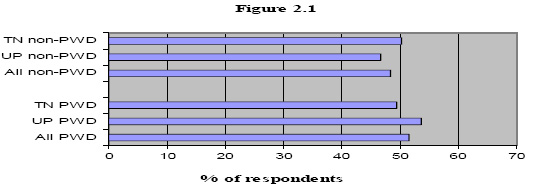
Source: UP and TN survey, 2005. % of respondents replying that disability was always/almost always a curse of God.
The UP and TN study surveyed just over 1400 households with and without disabled members about their attitudes to participation of PWD in some key social and economic activities. The three major activities assessed as critical to “normal” social participation of PWD were education, employment and marriage/family life. The survey also asked about participation in local community and political life.
Figure 2.2: Belief that disability a curse of God by disability type, rural UP and TN, 2005
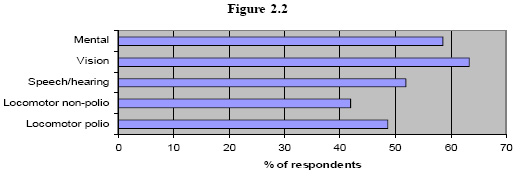
Source: UP and TN survey, 2005. % of respondents replying that disability was always/almost always a curse of God
With respect to education, people were asked under what circumstances children with specified disabilities could participate in regular school, and/or in special schools. Table 2.1 presents the findings on regular and special schooling. The table reports the share of respondents reporting that children with the indicated disabilities should always or almost always attend each type of school. Several interesting findings emerge:
- overall, there is low acceptance of children with disabilities attending regular schools. 4 At the same time, there are major differences by disability type in the acceptability of CWD attending regular schools. Acceptance that children with locomotor disabilities can always attend regular school is high (though acceptance that they could attend a special school is even higher). For those with vision and speech/hearing disabilities, only between a fifth and a quarter of respondents thought that they could always/almost always attend regular schools. However, for children with mental illness or retardation, there was very high agreement that they should never attend regular schools.
Table 2.1: Acceptance that children with disabilities should always attend special (top) and regular (bottom) schools, by disability type, UP and TN, 2005
Special School Non-PWD PWD Severe PWD Locomotor 96.7 95.3 96.2 Vision 91.1 87.2 88.3 Speech/hearing 86.5 82.5 83.4 Mental Ill 61.4 50.1 52.9 MR 60.8 51.9 54.0
Special School Non-PWD PWD Severe PWD Locomotor 81.8 80.6 80.4 Vision 25.7 27.8 25 Speech/hearing 21.3 19.9 19.9 Mental Ill 2 1.9 2 MR 1.1 1.3 1.3
Source: UP and TN survey, 2005. Bank staff estimates. - for children with mental illness and mental retardation, almost half of respondents (including in PWD households) did not think that they could always attend either regular or special school. This confirms the much more serious attitudinal issues with respect to children with these disabilities.
- perhaps the most interesting overarching result is that households with disabled or severely disabled members exhibit very similar attitudes to those of households without disabled members. The small differences indicate slightly less willingness of households with disabled members to accept attendance of disabled children in regular schools.{mospagebreak}
Previous research has pointed to significant challenges for persons with disability in getting married and having families.5 Even where marriage can be arranged, disabled women in particular are frequently married to much older men, and rates of divorce and abandonment have been found to be high, as the NSS data on widowhood among disability would seem to support. Attitudes to marriage and family life were also asked in the current study and the findings are presented in Figures 2.3 and 2.4. A few observations emerge:
- overall, unconditional acceptance of a PWD marrying a non-PWD was found in only around half of households. This did not show much state variation. Qualitative work undertaken in parallel with the survey revealed that there was wider acceptance of PWD men marrying non-PWD women than the reverse, particularly if the men were well-off. 6 The insight is supported by survey findings from Gujarat of women with disabilities having more than double the rate of spouses with disabilities. 7 In addition, communities indicated that it would generally be easier for people with the same disabilities to marry.
- at the same time, more than a quarter of households in TN felt that a PWD should never marry a non-PWD. On this issue, the difference with UP were very pronounced.
- despite the majority acceptance of the possibility of PWD/non-PWD marriage, around half respondents felt that dowry would always need to be adjusted in such cases.
Figure 2.3: Acceptance of PWD marrying non-PWD
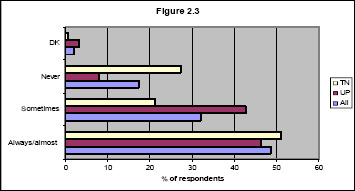
Figure 2.4: Opinion on need for dowry adjustment if PWD marries non-PWD
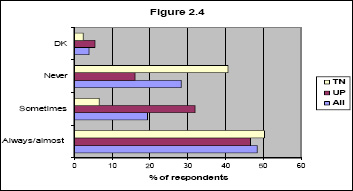
UP and TN village surveyan’t say.
An important associated question was the perceived capacity of women with different disabilities to have children and care for them. Much sociological literature from India notes the fundamental importance of these roles in defining womanhood. 8 Exclusion from marriage and child rearing results in “social obscurity and annulment of femininity”.9 The results from the UP and TN survey are presented in Table 2.2 below by disability type on the proportion of households agreeing with the statement that women with specific disabilities can always/almost always have and care for children. The main points to note are:
- overall, positive perceptions on the ability of disabled women to have and care for children are minority views.
- there is strong variation by disability type in position perceptions, with again mental illness and mental retardation attracting the strongest negative attitudes.
- there are sharp variations by state in the perceptions with respect to different disabilities.
Table 2.2: Positive perceptions of capacity of women with disabilities to have and care for children, UP and TN, 2005 (%)
| Disability | All | UP | TN |
| Locomotor | 53.7 | 65.8 | 41.4 |
| Vision | 34.8 | 58.6 | 10.6 |
| Hearing/speech | 65 | 57.7 | 72.5 |
| Mental illness | 6.9 | 13.4 | 0.3 |
| MR | 3.6 | 7.2 | 0 |
Source: UP and TN village survey, 2005. % of respondents answering “always/almost always” to statement “Women with [specified] disabilities are capable of having and caring for children”.
A final important element of intra-household attitudes and community views relates to violence against women with disabilities. This is a subject on which little quantitative research has been done to date in India. However, a recent study from Orissa indicates that women with disabilities were subject to significant domestic abuse and sexual abuse, and that the situation was sharply worse for women with mental impairments relative to women with other types of disabilities. 11 Results are presented in Figure 2.5 below. The results for rape are the most shocking, with fully one quarter of women with mental disabilities reporting having been raped (with the large majority carried out by family members), and almost 13 percent of women with locomotor, visual and hearing disabilities. In only a small share of cases did the women report the abuse to her family, and in the vast majority of those cases the reaction of the family was either not to listen or to pretend nothing had happened.
Women with disabilities in Orissa report high rates of physical and sexual abuse, particularly for women with mental disabilities
Figure 2.5: Women with disabilities reporting physical and sexual abuse, Orissa, 2005
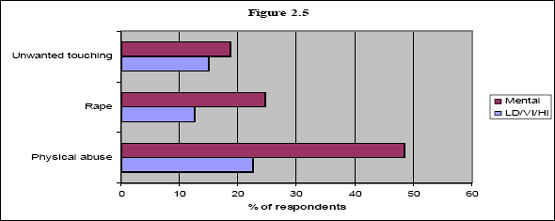
Source: Swabhiman (2005). Physical abuse = “being beaten at home”. Unwanted touching = “touching, pinching etc”.
In the UP and TN survey, households were also asked about participation of PWD in community activities like festival and religious celebrations, and on participation in local political and group activities such as gram sabhas and farmers’ associations. The results, presented in Figure 2.6, are far more positive than several of the attitudes presented above. Overall, there was high agreement with the proposition that PWD should always be allowed to participate in community activities, and almost as strong agreement that they should be included in local political and group activities. In both cases, the share of respondents indicating that PWD should never be allowed to participate was only around 1 percent.
Interestingly however, with respect to participation in community activities, qualitative work with the same communities found that the initially positive responses weakened during deeper discussion, with concerns for certain celebrations such as weddings that the presence of PWD may be inauspicious. This more nuanced situation is supported by research from Orissa finding low rates of participation by disabled women in religious and social life, with the situation much worse for women with mental impairments. 12 Research in Gujarat has also found that people with disabilities attended only around half of social and religious functions and were often discouraged from attending marriages. 13 With respect to local political participation, households with PWD had similar (high) voting rates to non-PWD households in gram sabha elections, though somewhat lower attendance rates as meetings.
Attitudes to participation in community and political life of PWD are much more positive
Figure 2.6: Positive attitudes to PWD participation in community and political activities, UP and TN, 2006
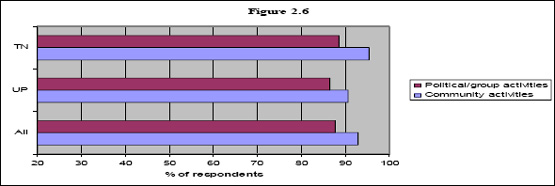
Source: UP and TN village survey, 2005. % of respondents answering always/almost always to participation of PWD.
The final attitudinal questions were about whether PWD can be successfully employed and the results are presented in Figure 2.7. A few points emerge:
- overall, the assessment of PWD capacity for successful employment is low. Even in the best case (locomotor disability) only half of respondents felt that PWD could be always/ almost always successfully employed. This share fell to less than 30 percent for vision impairments, and was less than 2 percent for both mental illness and mental retardation. In contrast, respondents felt that people with mental illness could never be successfully employed in 86 percent of cases, and for mental retardation the share was 78 percent.
- there is major variation in attitudes to the possibility of successful employment by disability type, with mental disabilities experiencing the most negative attitudes. For the other three categories, the shares are higher. In addition, around a further third of respondents felt that those with locomotor, vision and hearing/speech disabilities could be successfully employed sometimes. The variation by disability type is consistent with previous research in rural south India, though the relative impact of different disabilities varied, with for example a strong premium placed on visual acuity but notably less on hearing capacity (reflecting the demands of agricultural work).
- while the above findings are perhaps not surprising, the major variation between UP and TN on attitudes to non-mental disabilities was less expected. More research is needed on the drivers of such differences. Part of the explanation may lie in commonness of disabilities in different areas, as for example the incidence of locomotor disabilities from polio is higher in UP and may be associated with more accepting attitudes.
An additional interesting finding on employment is that responses by PWD themselves to the same question revealed surprisingly similar results in terms both of low share of respondents answering positively on PWD employment capacity and in terms of the variation in positive response shares across disability types. In all cases, the share of PWD answering positively was slightly lower than for household heads, indicating that there is a major self-esteem agenda among PWD to be addressed in order to improve their labor market outcomes.{mospagebreak}
Strong positive attitudes to PWD employment capacity are low, and there is major variation in attitudes to PWD employment, both by disability type and location
Figure 2.7: Positive attitudes to PWD employment by disability by, UP and TN, 2005

Source: UP and TN Village Survey. Proportion of HH head respondents answering always/almost always to statement: “People with a disability can be successfully employed”.
All the above results are from households. In qualitative work, similar questions were addressed to key service providers and officials, including ANM/anganwadis, teachers, doctors, and panchayat representatives. Overall, the opinions of service providers were somewhat more inclusive with respect to participation of PWD in their services. The same did not appear to be the case with panchayat representatives, who largely reflected the views of their communities.
With respect to education, there has been more research on the attitudes of teachers and education administrators to CWD and their inclusion in regular school settings. This is discussed in Chapter 5. More broadly, much research remains to be done on assessing, and developing strategies to improve, the attitudes of public officials and service providers to PWD. Despite the PWD Act, some evidence suggests that these key groups – at least in some states - may continue to have negative attitudes towards PWD, as data from Orissa on attitudes to PWD presented in Table 2.3 demonstrates. The attitudes of corporates and workers in community institutions were more accepting than those of government officials, education and health workers.
Table 2.3 Government officials and education and health workers had the highest rates of negative attitudes towards PWD in Orissa
| Organization | % regarding PWD as burden |
| Government officials | 37 |
| Education providers | 38 |
| Police and court officials | 23 |
| Financial sector workers | 32 |
| Corporate workers | 19 |
| Community places | 10 |
| Transport workers | 12 |
| Hospital workers | 36 |
Source: Swabhiman (2005).
While providing empirical insights is useful, how to work on changing long held and sometimes culturally-grounded attitudes is of course much more challenging. It appears that the challenges will be particularly acute in the areas of mental illness and mental retardation. However, there are positive examples of NGOs working towards attitudinal change on disability, in some cases with quantifiable impacts. Some efforts have been broad-based, others focus on service provides in specific areas, while others work at a very localized level through CBR and other channels. One of the more ambitious, well-documented and high impact efforts at attitudinal change is outlined in Box 2.3. which demonstrates the potential impact of effective public/private partnership in spreading awareness and reducing stigma for disabilities. There are also many examples of NGOs working with educators and other community figures to change attitudes and outcomes, as illustrated by the example of Vikas Jyot Trust in Vadodara in Box 2.2.
|
Box 2.2: Development organisations successfully taking up disability issues at community level - Vikas Jyot Trust, Vadodar
VJT has been working for the past 30 years in the slums of Vadodara on the rights of women and children. It has been implementing several community based programmes and activities for street children, adolescent girls, women in distress, commercial sex workers and their children. After participating in an awareness and skill development workshop on inclusion of people with disabilities in development programmes the staff of VJT have now assumed a significant role in including them in their programmes. “It was only after we participated in this initiative that we became aware of the services available in the district for people with disabilities. Earlier we had very limited information and no idea of the possibility of including people with disabilities in development processes”, says Jyoti. Today VJT, without any additional resources, has assumed new roles in the community as far as people with disabilities are concerned. They identify people with disabilities; link them with the service providers; establish personal contact with people with disabilities and their families and enable them to work out individual plans; involve community to enhance acceptance of people with disabilities; orienting civil society (police, railway protection force, anganwadi and health workers, staff of remand and observation homes for children etc.) to the rights and needs of people with disabilities. One area where they have concentrated efforts is in getting children into schools. Using films, games, experience sharing and informal discussions, they facilitated interactions between children with disabilities and non-disabled children; teachers from mainstream schools that had admitted children with disabilities and those that had not done so; and parents of children with disabilities and parents of non-disabled children. This series of one-day interactions helped both the groups in each case to share their experiences, feelings, and hopes, barriers that they were facing and what they would like to and could do. It helped in highlighting the need for inclusion of children with disabilities, the support available from the government or otherwise for children with special needs, and the positive experiences as well as challenges of those who had attempted to be inclusive. Vikas Jyoti Trust has supported the enrolment of children with disabilities in mainstream schools and special schools. Source: Officer (2005) |
Conclusions and recommendations
Changing societal attitudes to people with disabilities, even among people with disabilities themselves at times, presents many challenges. However, a basic starting point is facts. The leprosy campaign and its impact are clear demonstration that part of the stigma attaching to disability is driven by ignorance (see Box 2.4). It will thus be critical that various public health, educational, and other general awareness campaigns of government and non-governmental sectors drive home the causes of disability, and that disability is not a pre-ordained event.{mospagebreak}
Changing attitudes to disability is likely to area where it is particularly important for governments to work with people with disabilities, NGO/DPOs, and communities. However, governments at all levels can work to identify effective change agents in their communities, and allocate explicit funding to support their activities. They can also contribute to raising the profile of people with disabilities through awards and other forms of recognition such as the national Awards for Persons with Disabilities, which are given to outstanding employers and persons with disabilities each year in International Day of Disabled Persons. 15 Finally, the potential of cultural performance and the arts for both transformation of self-perceptions among PWD and of the general community of their capacities is significant, as the experience of Ability Unlimited, a dance troupe of people with disabilities, demonstrates.
|
Changing attitudes of young people through dance
Ability Unlimited is a professional dance troupe of disabled people which provides training and employment opportunities for its members and also seeks to expose non-disabled people to the artistic capacities of people with disabilities. Founded in 1989 in Bangalore, it moved in the early 2000s to Delhi, where the group has performed to around 50,000 school children, and as well performances for the general population. It has also performed abroad in Malaysia, Finland, and in 2007 the USA. The troupe currently has a pool of around 150 performers of different socio-economic and caste backgrounds, who perform a dance repertoire including traditional Indian folk tales, “martial arts on wheels” performances of Thang (a Manipuri martial art with swords), stories of the life of Buddha and other material. In its own words, Ability Unlimited “is committed to changing apathy, negativity and fear that surrounds education, employment and inclusion of persons with disabilities in arts by providing equal access to arts for them”. School students pay to view the performances, as well as being exposed to issues such a lack of accessibility of school premises by assisting the disabled performers in set-up. It also acts as an important form of dance therapy for the performers. Feedback from children seeing performances indicates positive impacts on their perceptions of people with disabilities and their capacities, including among parents of the performers themselves. Media reactions also attest to the impacts on audience of all ages: “It is for the first time that we have seen a holistic mega therapeutic theatre project of this magnitude…where all the participants are physically and mentally challenges…Movement with wheelchairs and crutches was immaculately timed to different choreographic patterns”. The Hindu. “Therapeutic ballet by special kids steals show”. The Asian Age. “Though they are our children, we never knew that they had so much in-built power within them, now we feel proud to be called their parents, and will definitely encourage them to pursue their dreams which are possible now”. Parent reaction quoted in New Straits Times, Malaysia For more information, go to www.abilityunlimited.com |
A second important step where media, persons with disabilities, social activists, and NGOs are likely to have comparative advantage is putting the experience and success stories of persons with disabilities into the public arena. This is increasingly being done, but at times in ways that characterize disabled people as objects of pity or “superhuman” in dealing with their disabilities. However, this is not always the case, as the powerful work of activists such as Harsh Mander demonstrates. 16 Equally, the disability movement is becoming more effective in disseminating insights into the lives of persons with disabilities through vehicles such as the Success and Ability quarterly of the Ability Foundation in Chennai.
The most powerful impacts, however, are likely to be felt at the individual level. An important step in this regard is following the guidance offered by people with disabilities in India on interactions with disabled people. Their “simple tips” are as follows:
- listen to the person with the disability. Do not make assumptions about what the person can or cannot do.
- when speaking with a person with a disability, talk directly to that person, not through her companion.
- extend common courtesies to people with disabilities as you would to anyone else. Shake hands or hand over business cards. If the person can not shake your hand or grasp your card, they will tell you. Do not be ashamed of the attempt however.
- offer assistance to a person with a disability, but wait until your offer is accepted before you help.
- it is okay to feel nervous or uncomfortable around people with disabilities, and it is okay to admit that. When you encounter these situations, think “person” first instead of disability and you will eventually relax.
- when meeting a person who is visually impaired, always identify yourself and others who may be with you.
- speak naturally to a hearing impaired person and do not exaggerate or over-emphasize your speech, as this will be easier for the person to “see” the word.
- when speaking with a person who uses a wheelchair or crutches, place yourself at eye level in front of the person.
- treat adults as adults. Address people with disabilities by their first names only when extending the same familiarity to others.
- never pretend to understand the speech of a person with a disability if you are having difficulty doing so.{mospagebreak}
|
Raising awareness and changing attitudes to leprosy
Since 1983, leprosy has been easily curable with Multi-Drug Therapy. The biggest remaining barrier to eliminating the disease is ignorance and stigma. The BBC World Service Trust developed a campaign in India to address this, in partnership with Doordarshan TV and All-India Radio. The campaign underlined the fact that leprosy is totally curable and that drugs are available free throughout India. It also stressed that leprosy is not spread by touch and that people with leprosy should not be excluded from society. The various methods and details included:
|

